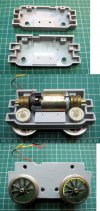And so the saga continues ......

After reassembling the loco, I gave her a test run. Still very disappointing in terms of pulling power. Even with a standard load of eight goods wagons the loco really struggled up my 1:40 gradients which my other locos gallop up. It also slowed appreciably on curves; the curve on the gradient brought it to a snail's pace on full power. I discovered the gauge on the drivers was slightly wide, but pushing the wheels tighter on to the gears to bring them to gauge made minimal difference. I stripped the motor block down to see if my clamshell was rubbing on anything. Nothing evident but I filed possible pinch points just in case. I reassembled and found there was very little improvement.
In desperation, I assembled the motor block which JimmyB had kindly sent me - which looks almost new.
Another test run and exactly the same outcome! Too little power to cope with a standard train!!
I can only assume that, for whatever reason (friction and/or my leverage theory), the large worms seriously impede the motor's ability to transmit power.
My next resort is to see if I can replace the worms with smaller diameter versions. I've ordered a gear puller and have found out how to calculate the mod value of the worm wheels. I just hope I can find a couple of replacements somewhere......
I will not be defeated!!


Rik



